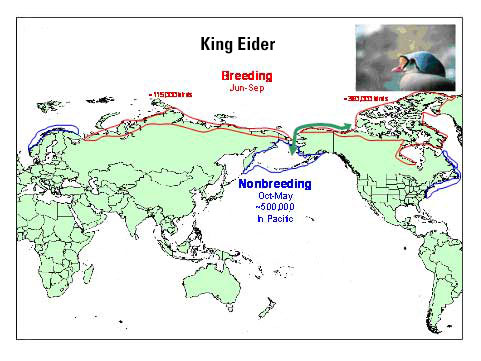King Eider, Somateria spectabilis
High-Priority Species ListSampling locations: Primary locations include Point Barrow and the Beaufort Sea Lagoon area near Prudhoe Bay.
Sampling timeframe: May/June and July/August.
Sampling demographics: Adults will be sampled during spring and fall migration. It is likely that an equal ratio of males and females will be obtained during migration sampling.
Methods of capture: Samples of spring and fall migrants will come from hunter harvested (subsistence) birds near Point Barrow and from fecal samples collected from birds flushed from roosting areas in the Beaufort Sea Lagoon area.
Other targeted species: At Point Barrow it will also be possible to sample long-tailed ducks and common eiders. Glaucous gulls, long-tailed ducks, and common eiders will also be sampled for feces in the Beaufort Sea Lagoon area.
U.S. Geological Survey
Contact: John Pearce
North Slope Borough
LGL Limited, Environmental Research Associates
Mehl, K., R. Alisauskas, K. Hobson, and D. Kellett. 2004. To winter east or west? Heterogeneity in winter philopatry in a central-arctic population of King Eiders. Condor 106:241-251.
Pearce, J., S. Talbot, B. Pierson, M. Petersen, K. Scribner, D. Dickson, and A. Mosbech. 2004. Lack of spatial genetic structure among nesting and wintering King Eiders. Condor 106:229-240.
Suydam, R. 2000. King Eider (Somateria spectabilis). In A. Poole and F. Gill (eds.), The birds of North America, Inc., Philadelphia, PA.

Ranking Score: 10.0 (lowest score of the waterfowl species ranked. However, the King Eider occurs in sympatry with Steller's, Common, and Spectacled eiders during spring migration, breeding, fall migration and during times of flightless molt)
Asian H5N1 ranking criteria for King Eider, Somateria spectabilis.
Total of partial contact with Asia1 |
Contact with known "hot spot"2 |
Habitat used in Asia3 |
Pop. in Alaska4 |
Can samples be obtained? |
Score |
2.0 |
1.0 |
2.0 |
3.0 |
2.0 |
10.0 |
Approx. 150,000 breed in northeastern Russia |
No known use of AI-infected areas |
Breeds in moist and uplands tundra |
Approximately, 360,000 breed in northern Alaska and western Canada |
Could be difficult to obtain target numbers in most locations |

